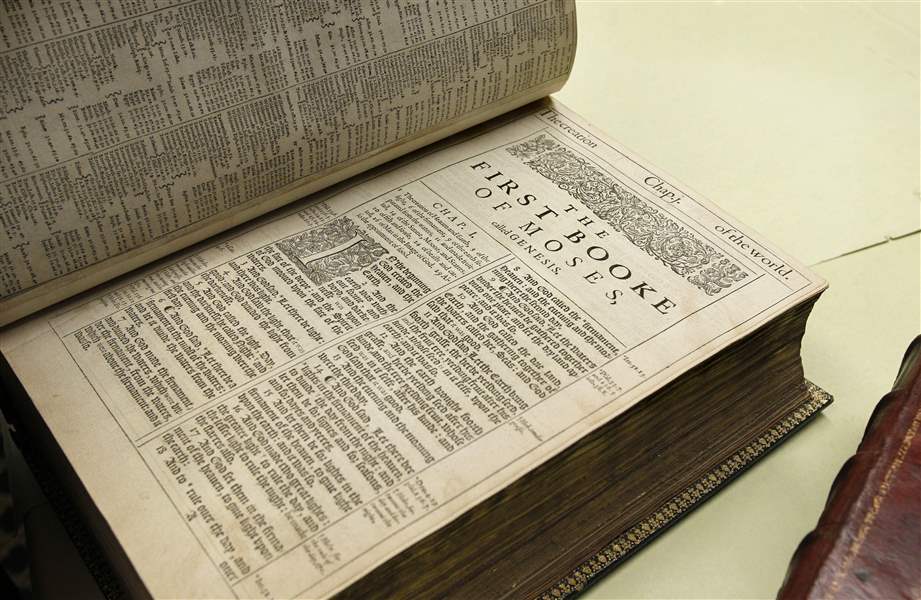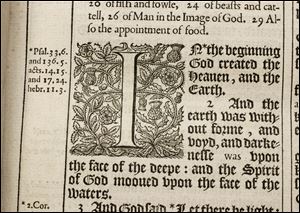
Museum to mark King James Bible's 400th
9/10/2011
Close-up of one of two 400-year-old first edition King James Bibles that will be going on display at the Toledo Museum of Art.
BLADE PHOTO/DAVE ZAPOTOSKY

Close-up of one of two 400-year-old first edition King James Bibles that will be going on display at the Toledo Museum of Art.
On Friday, the Toledo Museum of Art will celebrate the 400th anniversary of the King James Bible by putting its own rare first edition of the historic Bible on display.
Originally known as the Authorized Version, the translation was commissioned by King James I of England in 1604 and took 47 scholars nearly seven years to complete. The third English translation of the Bible, following the Great Bible and the Bishop's Bible, the King James Bible was printed by "the printer to the king," Robert Barker. It is acknowledged as one of the most influential books in history for both its religious and its literary content.
The Toledo museum's Bible that will be displayed through Dec. 3 in Gallery 15 is identified as an early first edition because of a woodcut engraving border on the title page. The distinctive border was printed in only a few copies until Flemish artist Cornelius Boel completed an engraved title page.
The museum has slated a series of programs related to the King James Bible exhibit, starting with a lecture at 7 p.m. Friday by Ed Hill, works-of- art-on-paper assistant, on how the authenticity of the museum's early edition was confirmed.
Other presentations include a talk at 7:30 p.m. Oct. 14 by the Rev. Margaret and the Rev. Gregory Sammons, co-rectors of St. Michael's in the Hills Episcopal Church in Toledo, on "How the King James Bible Came to Be"; a lecture at 2 p.m. Nov. 6 on art and martyrdom by University of Toledo English professor Matthew Wikander, and a presentation at 2 p.m. Dec. 4 on the language of Shakespeare and the King James.

The detail of a page in one of two 400-year-old first editions of the King James Bible at the Toledo Museum of Art shows a thistle-and-rose pattern and notes.
While there are many dozens of English translations of the Bible today, the King James remains one of the two best-selling Bibles in the United States, along with the New International Version (first published in 1978). Together, the King James and the New International account for more than half of the Bible units sold in the United States each year, according to a 2006 market study by Zondervan publishers.
A 2006 report by Publishers Weekly said the annual retail value of all Bibles sold in the United States is $500 million, with between 25 million and 26 million units sold each year.
The King James version has been lauded by many prominent people, including Winston Churchill, who called it a "masterpiece," and George Bernard Shaw, who described it as "beautifully artistic" and "magnificent."
Famous British atheist and evolutionary biologist Richard Dawkins read the biblical book of Ruth for a YouTube project and said of the King James Bible: "It is important that religion should not be allowed to hijack this cultural resource."
Celebrations marking the 400th anniversary of the King James Bible included public readings of the entire Bible, including a Braille reading next month in London's Trafalgar Square. A King James Bible Conference set for Nov. 13-16 in Lexington is being co-sponsored by the Sword of the Lord Ministries and the Church Bus News.
A loosely affiliated group of churches has formed a "King James Only" movement, holding that the 400-year-old version is the sole Bible for their use.
Paul Franklyn, associate publisher of the Common English Bible, said there is "a bit of a fanatic tinge" to those who assert that there are no other acceptable versions except the King James.
The fact that the Bible was translated from the original Hebrew, Greek, Aramaic, and other ancient languages doesn't deter some from believing that the King James Bible has a uniquely sacred significance.
As an example, Mr. Franklyn recalled driving along an Interstate highway in Nashville when he saw a man holding a sign that read, "The King James Bible was good enough for Jesus and it should be good enough for you."
-- David Yonke